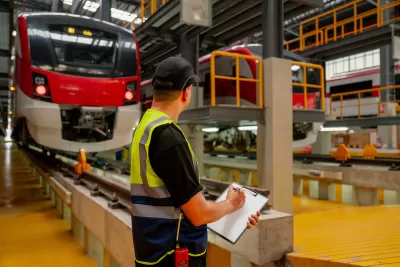Already understaffed, most of the nation’s transit agencies will need to replace a majority of their workers due to retirement, but recruitment efforts are not yet keeping up with the need.

Public transit agencies will have to replace most of their maintenance workers by the end of the decade, according to a new report from TransitCenter.
Writing in Governing, Jared Brey explains, “The report, Developing Transit Talent Pipelines, is the last in a series that has examined workforce challenges in the industry over the last several years.” As many transit workers reach retirement age and recruitment lags, agencies “have much more work to do to solve the challenge — and prevent it from making public transit’s woes much worse.” Currently, roughly 13 percent of mechanic positions in the industry are vacant, forcing service cuts in some fleets.
The report concludes with recommendations for filling staffing gaps that include apprenticeship programs, expanded efforts to recruit diverse populations, competitive compensation, good workplace culture, and more funding directed to workforce development. “Above all, transit agencies need to steadily improve job quality to make transit jobs attractive to young workers.”
FULL STORY: Transit Agencies Must Replace Most Maintenance Workers This Decade

Manufactured Crisis: Losing the Nation’s Largest Source of Unsubsidized Affordable Housing
Manufactured housing communities have long been an affordable housing option for millions of people living in the U.S., but that affordability is disappearing rapidly. How did we get here?

Americans May Be Stuck — But Why?
Americans are moving a lot less than they once did, and that is a problem. While Yoni Applebaum, in his highly-publicized article Stuck, gets the reasons badly wrong, it's still important to ask: why are we moving so much less than before?

Using Old Oil and Gas Wells for Green Energy Storage
Penn State researchers have found that repurposing abandoned oil and gas wells for geothermal-assisted compressed-air energy storage can boost efficiency, reduce environmental risks, and support clean energy and job transitions.

Greening Oakland’s School Grounds
With help from community partners like the Trust for Public Land, Oakland Unified School District is turning barren, asphalt-covered schoolyards into vibrant, green spaces that support outdoor learning, play, and student well-being.

California Governor Suspends CEQA Reviews for Utilities in Fire Areas
Utility restoration efforts in areas affected by the January wildfires in Los Angeles will be exempt from environmental regulations to speed up the rebuilding of essential infrastructure.

Native American Communities Prepare to Lead on Environmental Stewardship
In the face of federal threats to public lands and conservation efforts, indigenous groups continue to model nature-centered conservation efforts.
Urban Design for Planners 1: Software Tools
This six-course series explores essential urban design concepts using open source software and equips planners with the tools they need to participate fully in the urban design process.
Planning for Universal Design
Learn the tools for implementing Universal Design in planning regulations.
Heyer Gruel & Associates PA
City of Moreno Valley
Institute for Housing and Urban Development Studies (IHS)
City of Grandview
Harvard GSD Executive Education
Salt Lake City
NYU Wagner Graduate School of Public Service
City of Cambridge, Maryland





























